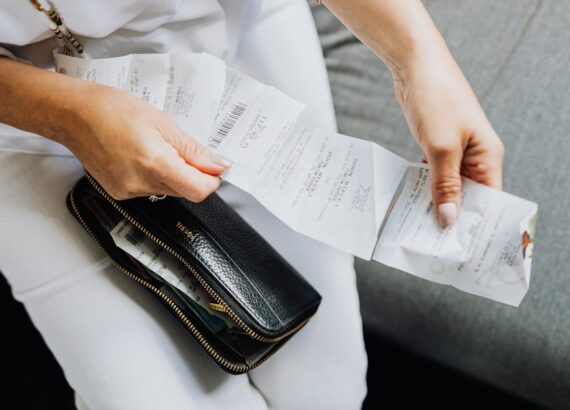
11 Bad Spending Habits and How to Break Them Today
Affiliate links may be used in this post. I may receive a small commission at no extra cost to you if you make a purchase through my affiliate link. Read my full disclosure policy here.
Break Free from Bad Spending Habits: A Guide to Smarter Finances
We’ve all been there – trapped in impulse purchases, mindless spending, and then regret. From online discounts to advertising or the mere thrill of the deal, poor spending habits can quickly take over and destroy our wallets and even relationships.
But do not worry, I am here to help and explore possibilities to get back on track. This blog will explore bad spending habits, why we get into these traps, and most importantly, learn simple ways to escape and regain control over our finances.
We’ve all been there – trapped in impulse purchases, mindless spending, and remorse. From online discounts to advertising or the mere thrill of the deal, poor spending habits can quickly take over and destroy our wallets.
But do not worry, we are not destined to lose all of these practices. This blog will explore bad spending habits, why we get into these traps, and most importantly, learn simple ways to escape and regain control over our finances.
Let’s take this journey together, and build a road map for more purposeful and deliberate spending.
Understanding the Psychology of Poor Spending Habit
We fall into the habit of overspending for a few reasons. Sourcing, emotional excitement and social pressure all play their part in these processes: we seek out short-term pleasure, or make purchases to relieve stress or boredom. Also, poor money management is a result of not knowing how to manage money, and widespread marketing and advertising can sway our buying patterns.
These habits, in the long run, become hard-wired, and it is difficult to evade overspending and impulse spending. It is important to learn about these hidden causes before you can make a move toward healthier money spending and greater financial stability. greater financial well-being.
1. Breaking the Cycle of Overspending: Spend less Than you Earn
Spending more than you earn, also known as living beyond your means, occurs when your expenses exceed your income. It is essentially the act of consistently spending money that you don’t have, often relying on credit cards, loans, or other forms of debt to cover the shortfall. This is unsustainable behavior can lead to a cycle of debt accumulation, financial stress, and an inability to build savings or invest for the future.
And Why it is Harmful? Living above your means creates dependency on credit, leading to high-interest payments and limiting savings for future goals. Over time, it makes financial independence and stability difficult to achieve.
How to Break the Habit
Set a Budget: Track your expenses to see where your money goes. Prioritize essentials and set clear limits for non-essentials.
Delay Impulse Purchases: Wait a few days before making discretionary purchases. This can curb unnecessary spending.
Avoid Credit for Discretionary Spending: Try using cash or a debit card to keep spending within your means.
Replacing this habit with mindful budgeting and intentional spending will help you achieve financial security and build a healthier relationship with money.

2. Not Knowing Where Your Money Goes
Not tracking where your money goes can be a major obstacle to financial stability. When spending is unmonitored, it’s easy to lose sight of how much you’re actually spending on things like dining out, subscriptions, or impulse purchases. Small, unnoticed expenses add up quickly, leading to budget shortfalls and financial stress.
Taking time to review your spending habits is key to identifying leaks in your budget and aligning your finances with your priorities. With awareness, you can make intentional choices, redirect funds toward savings, and build a healthier financial future.
Here’s how to break the habit of not knowing where your money goes:
Track Every Expense: Use a budgeting app or a simple spreadsheet to record each expense, no matter how small. This will show exactly where your money goes and reveal any spending patterns.
Review Monthly Statements: Look through bank and credit card statements to spot recurring charges or unexpected spending. Identify areas where you can cut back or eliminate unnecessary expenses.
Set Spending Categories: Create categories for essentials (like housing and groceries) and non-essentials (like dining out or entertainment). Allocate a specific amount to each category and track your progress.
Automate Savings First: Transfer a set amount into savings as soon as you receive your income. This prioritizes savings and reduces the risk of overspending on non-essentials.
Reflect Weekly: Take a few minutes each week to check your spending. This regular check-in helps you stay on track and adjust your budget if needed.
By regularly tracking and reviewing your spending, you can make better decisions, avoid overspending, and reach your financial goals faster.
3. Neglecting Emergency Fund
Neglecting an emergency fund can leave you vulnerable when unexpected expenses arise. An emergency fund acts as a financial safety net, protecting you from debt and giving you peace of mind during life’s surprises. Experts recommend saving three to six months’ worth of living expenses. Even if you start small, consistently building this fund will strengthen your financial stability and confidence.
How to Break the Habit
Set Clear Savings Goals: Determine a realistic amount to save each month and commit to reaching your emergency fund goal.
Automate Your Savings: Set up automatic transfers to your emergency fund to ensure consistency and remove the temptation to skip contributions.
Redirect Unnecessary Spending: Identify non-essential expenses and redirect that money toward your emergency savings.
Resist Non-Urgent Withdrawals: Avoid dipping into your emergency fund for anything that isn’t truly necessary, so you stay on track.
Review and Adjust Regularly: Monitor your progress monthly, adjusting contributions if your budget allows. Celebrating milestones along the way can also help keep you motivated.
By prioritizing and consistently building your emergency fund, you’ll create a solid foundation that brings peace of mind and financial resilience.

4. Living Beyond Your Means: Breaking Free from Overspending
Living beyond your means is a damaging spending habit characterized by consistently splurging on non-essential items and luxuries. This can include everything from designer clothing and high-end gadgets to lavish vacations. When individuals prioritize immediate gratification over long-term financial health, they often find themselves in financial strain, accumulating debt, and losing sight of important goals such as saving for retirement or building an emergency fund.
How to Break the Habit
Create a Realistic Budget: Start by assessing your income and expenses to craft a budget that reflects your financial situation. Ensure it includes categories for both necessities and discretionary spending.
Differentiate Needs from Wants: identify what is essential for your daily life versus what is a luxury. This awareness can help you make more informed spending decisions.
Set Spending Limits: Establish clear limits for non-essential purchases. Use these limits as guidelines to curb impulsive buys and stay within your budget.
Practice Delayed Gratification: When tempted by a non-essential item, wait 24 hours before making the purchase. This pause can help you determine if it’s a genuine need or just a fleeting desire.
Be Mindful of FOMO: Avoid comparing your financial situation to others, especially those portrayed on social media. Focus on your personal financial goals and the steps you need to take to achieve them.
Build an Emergency Fund: Prioritize creating an emergency fund as a financial cushion. This will help you feel more secure and reduce the urge to overspend for comfort.
Seek Support and Accountability: Share your financial goals with friends or family who can provide encouragement and hold you accountable in your journey towards financial responsibility.
By implementing these strategies and focusing on your financial priorities, you can break the cycle of living beyond your means, achieve greater stability, and enjoy peace of mind in your financial journey.
5. Neglecting Debt Repayment: A Path to Financial Strain
Not paying off debts and allowing interest to accumulate is a detrimental financial habit that can significantly impact your financial health. When individuals fail to prioritize debt repayment, they risk falling into a cycle of increasing interest charges, making it harder to achieve financial freedom. This neglect can lead to heightened financial stress, a decrease in creditworthiness, and limited opportunities to pursue other financial goals.
How to Break the Habit
Make Debt Repayment a Priority: Allocate a portion of your monthly income specifically for debt repayment. Treat this as a non-negotiable expense in your budget.
Tackle High-Interest Debts First: Focus on paying off debts with the highest interest rates first. This strategy minimizes the amount of interest you pay over time.
Consider Debt Consolidation: If you have multiple debts, look into consolidating them into one loan with a lower interest rate. This can simplify payments and reduce overall interest costs.
Negotiate with Creditors: Reach out to your creditors to discuss your repayment options. Many may be willing to negotiate more favorable terms, such as lower interest rates or extended payment plans.
Seek Professional Help: Consulting with a financial advisor or credit counselor can provide personalized strategies for managing debt and developing a solid repayment plan.
By taking these proactive steps and prioritizing debt repayment, you can break free from the cycle of accumulating interest and move toward greater financial stability.
Related Article: How To Pay off Your Debts and Live Your Best Life

6. Impulse Buying: Take Control of Your Finances
Impulse buying is a detrimental spending habit defined by spontaneous purchases made without careful consideration. This behavior often leads to overspending, clutter, and feelings of buyer’s remorse, ultimately hindering your financial goals and making it difficult to save for important priorities.
How to Break the Habit
Implement mindful strategies: One effective approach is to sleep on purchase decisions, allowing time to reflect on whether the item is truly necessary. Additionally, consider disabling notifications from shopping apps or deleting them altogether to reduce temptation.
Set clear spending limits and create a detailed shopping list: this can help you stay focused on what you need, while practicing mindfulness can empower you to resist impulsive urges. By redirecting your attention to meaningful activities and sticking to a budget, you can cultivate healthier spending habits and move toward greater financial stability and peace of mind.
7. Failing to Invest for the Future: A Barrier to Financial Growht
Neglecting to invest and make your money work for you is a significant bad spending habit. This behavior involves failing to allocate funds towards investments that have the potential to grow and generate passive income over time.
By not investing, individuals miss out on opportunities to build wealth, achieve financial independence, and secure their future. Instead, they may keep their money in low-yield savings accounts or spend it on immediate gratification, ultimately hindering their long-term financial well-being.
How to Break the Habit
Educate Yourself: Take time to learn about different investment options, strategies, and the benefits of investing early. Resources such as books, podcasts, and online courses can provide valuable insights.
Seek Guidance: Consult with experienced investors or financial advisors who can offer personalized advice and help you navigate the investment landscape.
Set Clear Financial Goals: Define your short-term and long-term financial goals, including how much you want to invest and what you hope to achieve through investing.
Start Small: Begin by allocating a small portion of your income towards investments. Gradually increase this amount as you become more comfortable with the process.
Monitor Your Investments: Regularly review the performance of your investments to stay informed and make necessary adjustments to your strategy.
Stay Disciplined and Patient: Building wealth takes time and discipline. Stay committed to your investment plan, and don’t be swayed by short-term market fluctuations.
By following these steps and prioritizing investment, you can unlock your financial potential and pave the way towards a brighter financial future.
8. Failing to Compare Prices and Negotiate
Not shopping around or negotiating prices can lead to overspending and missed opportunities to save money. This often-overlooked habit affects all types of purchasing decisions, from everyday items to significant investments. For example, individuals may renew insurance policies without comparing premiums, resulting in higher costs for potentially less coverage from other providers.
Similarly, failing to research and compare prices for appliances or electronics can lead to paying inflated costs unnecessarily. This habit not only contributes to overspending but also undermines opportunities for informed and cost-effective purchasing decisions. By actively seeking the best deals and comparing options, individuals can maximize savings and make smarter financial choices.
How to Break the Habit
Plan Ahead: Before making a purchase or renewing a policy, set aside time to research options and track deadlines to explore better alternatives.
Research and Compare Prices: Utilize online tools, comparison websites, and store flyers to gather information about prices across different retailers or service providers.
Negotiate Prices: Don’t hesitate to negotiate prices, whether you’re dealing with service providers or retail stores. Be prepared to walk away if a better deal isn’t offered.
Stick to Your Budget: Establish a clear budget for your purchases and adhere to it, allowing for informed decision-making rather than impulse buys.
Consider Alternatives: Explore different brands, models, or services that may offer better value for money, rather than defaulting to familiar choices.
By following these steps, you can break the cycle of overspending and enhance your ability to make financially savvy purchasing decisions.

9. Avoiding Second-Hand Purchases
Another habit to break is the reluctance to buy second-hand items. Embracing the second-hand market offers numerous benefits, including significant cost savings, reduced environmental impact through promoting reuse, and the chance to discover unique or vintage finds. By shifting attitudes toward pre-owned goods and exploring options like thrift stores, online marketplaces, and community swap events, individuals can save money, minimize waste, and contribute to a more sustainable lifestyle.
How to Break the Habit
Change Your Mindset: Shift your perception of second-hand items by recognizing their value and potential to save money while being environmentally friendly.
Explore Second-Hand Options: Make it a habit to check thrift stores, consignment shops, and online marketplaces before making new purchases.
Attend Community Swap Events: Participate in local swap events where you can exchange items with others, giving your goods a second life while finding something new.
Set a Second-Hand Budget: Allocate a specific amount in your budget for second-hand shopping to encourage exploration without guilt.
Research Quality Brands: Familiarize yourself with brands known for quality that often hold up well over time, making second-hand purchases a more viable option.
Be Patient and Persistent: Understand that finding the perfect second-hand item may take time and effort, but the rewards can be worth it.
By embracing the second-hand market, you can maximize your savings, contribute to sustainability, and uncover unique treasures while enjoying a more financially responsible lifestyle.
10. Over-Subscribing and Not Using the Service
Subscription creep refers to the gradual accumulation of multiple subscription services—such as streaming platforms, meal kits, magazine subscriptions, and premium apps—without a clear awareness of the costs involved. While subscriptions can provide convenience and entertainment, it’s easy to lose track of how much you’re spending each month.
Many people sign up for services they use infrequently, and before they know it, they are paying for several subscriptions that add up to a significant expense. This habit not only strains your budget but also often leads to unnecessary spending on services that may not align with your current needs or priorities.
How to Break the Habit
Review Your Subscriptions: Take an inventory of all active subscriptions and assess how often you use each one. This will help you identify which ones are worth keeping.
Set a Subscription Budget: Determine how much you are willing to spend on subscriptions each month and stick to that limit to avoid overspending.
Cancel Unused Subscriptions: Don’t hesitate to cancel subscriptions that you rarely use or those that don’t provide enough value. You can always resubscribe later if needed.
Take Advantage of Free Trials: If you’re unsure about a subscription, take advantage of free trials to evaluate whether the service meets your needs before committing.
Use a Subscription Management Tool: Consider using an app or service that tracks your subscriptions and reminds you of upcoming charges, helping you stay organized and in control.
Schedule Regular Reviews: Set aside time every few months to review your subscriptions again, ensuring that you’re still using and benefiting from each service.
Think Twice Before Signing Up: Before subscribing to a new service, ask yourself if it’s a need or a want and how it fits into your budget and lifestyle.
By implementing these strategies, you can break the cycle of subscription creep and make more intentional decisions about your spending, ultimately freeing up money for more meaningful financial goals.

Take Charge of Your Finances: Download Your Free Expenses Tracker!
Are you ready to take control of your spending habits and make smarter financial decisions? To help you on your journey, I invite you to download my free Expenses Tracker!
This handy tool will empower you to track your monthly expenses, identify patterns, and make informed choices about your spending. With your expenses clearly laid out, you can pinpoint areas for improvement and take actionable steps toward financial freedom. Don’t let overspending hold you back any longer—download the Expenses Tracker now and start your path to a more organized and financially savvy lifestyle!



